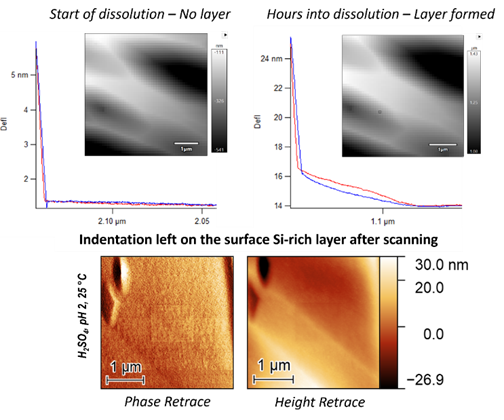Microscopic understanding of silica layers in olivine dissolution: leaching or reprecipitation?
Olivine ([Mg,Fe]2SiO4) is a promising material for Carbon Capture and Storage (CCS) technologies, as it naturally undergoes chemical weathering – the process in which minerals dissolve when exposed to chemicals in nature. Olivine acts as a source of cations that can react with CO2 in water to form stable minerals [1]. However, dissolution is slow and acts as a rate-limiting step. One of the reasons for that is the formation of Si-rich layers on top of its surface, limiting transport of ionic species from solid to solution. Atomic Force Microscopy (AFM) is a powerful tool to image the changes in surface morphology during dissolution and can be used to characterize the process [2]. Early-stage dissolution at the micrometric scale is dominated by the formation of etch pits, whose properties are determined by the crystallography of the solid and composition of the reactive solution.
Research objectives
In this project, you will dissolve a polished olivine pebble in acidic solutions at pH 2 and evaluate the mineral’s response through the analysis of the Force-Distance curves (Force Spectroscopy) [3]. The formation of the layer can be inferred by detecting soft structures on the surface that modify the response of the AFM cantilever. Your task will be to analyze the variations in response of the cantilever through force spectroscopy over time and space. Through this project, you will contribute to the understanding of early stage olivine dissolution and the role soft layers have on the reaction.
Learning objectives
Besides the common objectives for a BSc project, you will also learn the basics of in-situ AFM and complementary techniques. Data analysis and interpretation, a key component of the project, will involve AFM images, hyperspectral maps (where at each point corresponds a force-distance curve) and time series of force-distance curves.

[1]: E.H. Oelkers et al., Chemical Geology 2018 (review on olivine dissolution) *review on carbonation
[2]: X. Li et al., Applied Surface Science 2021 (AFM to analyze olivine dissolution)
[3]: AFM Workshop, Measuring and Understanding Force Distance Curves
Daily supervision: Vincenzo Alagia
Promotor: Igor Sîretanu
